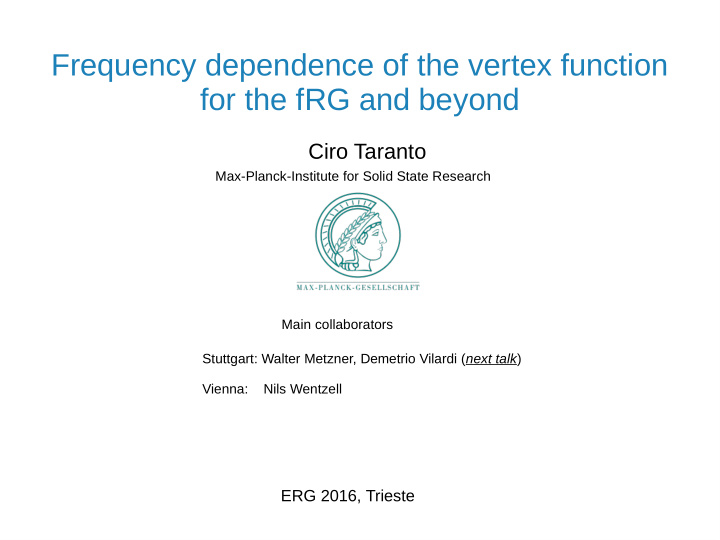



Frequency dependence of the vertex function for the fRG and beyond Ciro Taranto Max-Planck-Institute for Solid State Research Main collaborators Stuttgart: Walter Metzner, Demetrio Vilardi ( next talk ) Vienna: Nils Wentzell ERG 2016, Trieste
Outline Vertex frequency dependence (Part I) ● – Definitions, 1PI and 2PI vertexes – Diagrammatic understanding of the vertex structures – Vertex decomposition (and reconstruction) Towards strong coupling (Part II) ● – Apllication: combining DMFT and fRG (DMF 2 RG) continued in next talk
1PI vertex in (fermionic) fRG 2-particle picture:
1PI vertex in (fermionic) fRG 2-particle picture: Review: Metzner et al., RMP '12
1PI vertex in (fermionic) fRG 2-particle picture: fRG: Momentum dependence→ leading instabilities; calculation of susceptibilities This talk: Systematic analysis of frequency dependence Review: Metzner et al., RMP '12
Notation conventions “fermionic” 4-vector “bosonic” 4-vector
Notation conventions “fermionic” 4-vector “bosonic” 4-vector
Notation conventions “fermionic” 4-vector “bosonic” 4-vector Computed in fRG Plot a fixed transfer frequency Diagonal & horizontal frequency structure → Large frequency behavior
Decomposing the vertex Parquet equation
Decomposing the vertex Parquet equation 2-particle irreducible
Decomposing the vertex Parquet equation 2-particle irreducible Rohringer,Valli and Toschi,PRB'12
Decomposing the vertex Parquet equation ED result 2-particle irreducible No two-particle irreducible terms in fRG at one-loop truncation level Rohringer,Valli and Toschi,PRB'12
Decomposing the vertex Parquet equation fRG : integrate each channel separately 2-particle reducible
Decomposing the vertex Parquet equation fRG : integrate each channel separately 2-particle reducible
Decomposing the vertex Parquet equation fRG : integrate each channel separately 2-particle reducible
Decomposing the vertex Parquet equation fRG : integrate each channel separately 2-particle reducible
Decomposing the vertex Parquet equation fRG : integrate each channel separately 2-particle reducible
Decomposing the vertex Parquet equation fRG : integrate each channel separately 2-particle reducible Can one further understand the structures?
Diagrammatic classification Assumption : Bare interaction Local and frequency independent Lowest order: Dependence on transfer arguments only, often used in fRG: Karrasch , et al., JPCM 2008 (frequencies); Husemann and Salmhofer, PRB 2009 (momenta) Bauer, Heyder and von Delft, PRB 2014 (inhomogeneous systems) Generalization this argument for higher order diagrams?
Diagrammatic classification Direct connection with susceptibilities
Diagrammatic classification Direct connection with susceptibilities
Diagrammatic classification Direct connection with susceptibilities
Diagrammatic classification scan
Diagrammatic classification
Diagrammatic classification - - = Subleading at weak coupling Full argument dependence: numerically expensive Possibly relevant for d- wave scattering
Vertex: decomposition and reconstruction Computed in a finite box
Vertex: decomposition and reconstruction fRG: separate channel integration From the full vertex: Bethe- Salpeter equations Computed in a finite box
Vertex: decomposition and reconstruction fRG: separate channel integration From the full vertex: Bethe- Salpeter equations Computed in a finite box Extract Extend
Vertex: decomposition and reconstruction fRG: separate channel integration From the full vertex: Bethe- Salpeter equations Computed in a finite box Extract Extend Extract
Vertex: decomposition and reconstruction fRG: separate channel integration From the full vertex: Bethe- Salpeter equations Computed in a finite box Extract Extend Extract Check that it decays inside Extract the box
Part I: conclusions 1.The interaction vertex shows a nontrivial frequency structure 2.The vertex structure can be understood diagrammatically 3.The knowledge of the vertex asymptotic can be used to reduce computational effort Part II: DMF 2 RG and strong coupling ● Dynamical mean field theory in a nutshell ● Starting fRG from a correlated starting point
Flowing from infinite to d -dimensions ● Goal: combine non-perturbative local physics from DMFT with nonlocal fluctuations from fRG Georges et al., RMP 1996 Georges et al., RMP 1996 ● In the ∞-dimensional limit local approximation for the self-energy becomes exact Metzner and Vollhardt , PRB 1989; ● Mapping on an Anderson Impurity model embedded in a self-consistent frequency-dependent bath ( MF in space ) Georges and Kotliar, PRB 1992 ● The Anderson Impurity model can be exactly solved (QMC, ED, …) good starting point for the flow equations Conceptual steps: (1) Approximate a lattice model with an ∞-dimensional lattice (with the same DOS) (2) Exactly solve the problem in infinite dimensions (3) Flow from the infinite dimensional lattice to the original one using fRG Taranto , et al.,PRL 2014;
Flowing from infinite to d -dimensions Taranto , et al.,PRL 2014;
Flowing from infinite to d -dimensions Taranto , et al.,PRL 2014;
Flowing from infinite to d -dimensions DMFT self-consistency condition for the Weiss field Georges,cond-mat/0403123 (2004) Taranto , et al.,PRL 2014;
Flowing from infinite to d -dimensions DMFT self-consistency condition for the Weiss field Georges,cond-mat/0403123 (2004) Taranto , et al.,PRL 2014;
Flowing from infinite to d -dimensions DMFT self-consistency condition for the Weiss field Georges,cond-mat/0403123 (2004) More freedom in the regulator Taranto , et al.,PRL 2014;
Flowing from infinite to d -dimensions Effect of the frequency dependence in the next talk Taranto , et al.,PRL 2014;
Part I: conclusions 1.The interaction vertex shows a nontrivial frequency structure 2.The vertex structure can be understood diagrammatically 3.The knowledge of the vertex asymptotic can be used to reduce computational effort Part II: DMF 2 RG and strong coupling ● Dynamical mean field theory in a nutshell ● Starting fRG from a correlated starting point
Recommend
More recommend